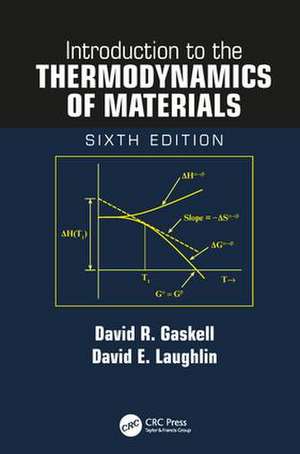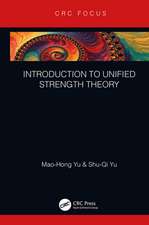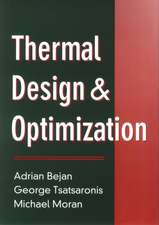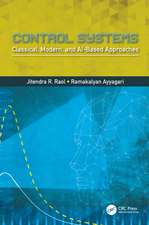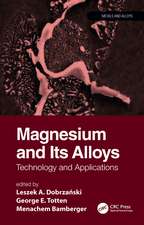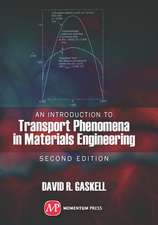Introduction to the Thermodynamics of Materials
Autor David R. Gaskell, David E. Laughlinen Limba Engleză Hardback – 18 aug 2017
Preț: 942.31 lei
Preț vechi: 1035.51 lei
-9% Nou
Puncte Express: 1413
Preț estimativ în valută:
180.31€ • 188.26$ • 149.23£
180.31€ • 188.26$ • 149.23£
Carte disponibilă
Livrare economică 15-29 martie
Livrare express 01-07 martie pentru 57.42 lei
Preluare comenzi: 021 569.72.76
Specificații
ISBN-13: 9781498757003
ISBN-10: 1498757006
Pagini: 714
Ilustrații: 11 Tables, black and white; 259 Illustrations, black and white
Dimensiuni: 156 x 234 x 42 mm
Greutate: 1.22 kg
Ediția:6 New edition
Editura: CRC Press
Colecția CRC Press
ISBN-10: 1498757006
Pagini: 714
Ilustrații: 11 Tables, black and white; 259 Illustrations, black and white
Dimensiuni: 156 x 234 x 42 mm
Greutate: 1.22 kg
Ediția:6 New edition
Editura: CRC Press
Colecția CRC Press
Cuprins
Thermodynamic Principles. Introduction and Definition of Terms. The First Law of Thermodynamics. The Second Law of Thermodynamics. The Statistical Interpretation of Entropy. The Fundamental Equations and Their Relationships. Heat Capacity, Enthalpy, Entropy, and the Third Law of Thermodynamics. Phase Equilibria. Phase Equilibrium in a One-Component System. The Behavior of Gases. The Behavior of Solutions. Gibbs Free Energy Composition and Phase Diagrams of Binary Systems. Reactions and Transformations of Phases. Reactions Involving Gases. Reactions Involving Pure Condensed Phases and a Gaseous Phase. Reaction Equilibria in Systems Containing Components in Condensed Solution. Electrochemistry. Thermodynamics and Phase Transformations. Appendices. A. Selected Thermodynamic and Thermochemical Data. B. Exact Differential Equations. C. The Generation of Additional Thermodynamic Potentials as Legendre Transformations.
Notă biografică
David R. Gaskell received a B.Sc. in Metallurgy and Technical Chemistry from the University of Glasgow and a Ph.D. from McMaster University. Dr. Gaskell’s first faculty position was at the University of Pennsylvania, Philadelphia, where he taught from 1967 to1982 in Metallurgy and Materials Science. He was recruited in 1982 to Purdue University at the rank of Professor where he taught until 2013. During Dr. Gaskell’s career he served as a Visiting Professor, National Research Council of Canada, Atlantic Regional Laboratory, in Halifax, Nova Scotia (1975-1976) and as a Visiting Professor, G.C. Williams Co-operative Research Centre for Extraction Metallurgy, in the Department of Chemical Engineering, University of Melbourne (1995). He also held a position during his sabbatical in Australia as a Visiting Scientist, Commonwealth Scientific and Industrial Research Organisation (CSIRO), in Clayton, Victoria. Dr. Gaskell authored the textbooks Introduction to Metallurgical Thermodynamics, Introduction to the Thermodynamics of Materials, and Introduction to Transport Phenomena in Materials Engineering.
David E. Laughlin is the ALCOA Professor of Physical Metallurgy in the Department of Materials Science and Engineering of CMU and also has a courtesy appointment on the Electrical and Computer Engineering Department. He was the Principal Editor of Metallurgical and Materials Transactions from 1987 to 2016. David is a graduate of Drexel University (1969) and the Massachusetts Institute of Technology (1973). He is a Fellow of TMS, an Honorary member of AIME, and a Fellow of ASM International. He is also the recipient of several CMU awards for teaching and research excellence and a Distinguished Scientist of the TMS Electronic, Magnetic & Photonic Materials Division. He has authored more than 400 technical publications in the field of phase transformations, physical metallurgy, and magnetic materials, and has edited or coedited seven books including the fifth edition of Physical Metallurgy, and has been awarded 12 patents.
David E. Laughlin is the ALCOA Professor of Physical Metallurgy in the Department of Materials Science and Engineering of CMU and also has a courtesy appointment on the Electrical and Computer Engineering Department. He was the Principal Editor of Metallurgical and Materials Transactions from 1987 to 2016. David is a graduate of Drexel University (1969) and the Massachusetts Institute of Technology (1973). He is a Fellow of TMS, an Honorary member of AIME, and a Fellow of ASM International. He is also the recipient of several CMU awards for teaching and research excellence and a Distinguished Scientist of the TMS Electronic, Magnetic & Photonic Materials Division. He has authored more than 400 technical publications in the field of phase transformations, physical metallurgy, and magnetic materials, and has edited or coedited seven books including the fifth edition of Physical Metallurgy, and has been awarded 12 patents.
Recenzii
"I love this book and will strongly recommend it to my students. It is an excellent textbook for undergraduate students who are studying in materials science."
—Jongee Park, Atılım University, Ankara, Turkey
"A comprehensive book on thermodynamics in metallic systems with the underlying theory ‘crystal’ clear explained."
—Sybrand van der Zwaag, Delft University of Technology, Netherlands
"The book is logically organized in three sections: thermodynamic principles, phase equilibria, and reactions and transformations. Each chapter contains a summary and nearly every chapter provides detailed examples. The new edition includes additional thermodynamic work terms beyond pdV or Tds or udN such as magnetic work and how the fields within these work terms are experimentally relevant."
—Bill Knowlton, Boise State University, Idaho, USA
"The text is easy to follow for undergraduate students doing a course in thermodynamics of materials. The thermodynamic consideration of magnetic materials is particularly useful for graduate students working on magnetic materials. I find the effect of magnetism and magnetic work in the analysis very useful. The introduction of Magnetic flavor in this textbook set it apart from other books on thermodynamics of materials"
—Oh Joo Tien, Nanyang Technological University, Singapore
"This book gives a step-by-step introduction to the thermodynamics of materials. After an exposition of the fundamental concepts, examples of increasing difficulty are treated, which contain many ‘real-world’ applications. Many examples are laid out in details, and numerous diagrams are given to make sure that a solid understanding is reached. Therefore, this book gives solid foundations in thermodynamics for engineering students. Equipped with this knowledge, the students can go on toward more specialized studies or to the reading of research papers."
—Mathis Plapp, CNRS/Ecole Polytechnique, Palaiseau, France
"This book provides a solid foundation in the thermodynamic theory necessary for any study of Materials Science. It would be ideal for undergraduate students who are learning this topic for the first time, but is also useful as a refresher of the fundamentals for graduate students and researchers working in this field. The inclusion of worked examples and problems is particularly valuable in helping to practice the application of thermodynamic theory to real examples in Materials Science."
—Joseph Robson, University of Manchester, United Kingdom
"This book, Introduction to the Thermodynamics of Materials, Sixth Edition, is very suitable to be a text book for undergraduate students. This book can easily bring them to enter the world of Thermodynamics of Materials and make them well know concept about Thermodynamics. I always tell my friends and colleagues that this book is the Bible of the ‘Thermodynamics of Materials.’ In Taiwan, this book is also a text book for graduated school entrance examinations."
—Yee-Wen Yen, National Taiwan University of Science and Technology
"This text is by far the best text I have yet found for teaching thermodynamics to undergrads. I believe the emphasis on graphical representations of thermodynamic data is a very real strength for interpreting this material to the beginner. I also see significant improvements in the organization that provides greater clarity. The addition of qualitative example problems at the end of each chapter is welcome. The new Chapter 15 is a valuable contribution. This chapter is probably unlikely to be used in undergraduate teaching, but it will be extremely useful for a new generation of graduate students."
—Garry Warren, University of Alabama, USA
"…this new edition of classic book on thermodynamics of materials written by two stalwarts in the subject, Professors David R. Gaskell and David E. Laughlin, is the need of the hour. Although Professor Gaskell is not among us physically to inspire us, his legacy will be seen whenever we open this book on thermodynamics of materials. A great effort from Professor Laughlin in bringing out this revised edition."
—Koteswararao V. Rajulapati, University of Hyderabad, India
"This textbook has a very rigorous and deep approach to chemical thermodynamics. It is very clear in explaining the complex meaning of the thermodynamics rules and equations, starting from the potentials and their use to solve thermodynamics problems. Without being too advanced, it reaches all the necessary points for a thorough discussion of the matter, even entering in some detail which is not often taught in the undergraduate courses, I really appreciate the clarity and the accuracy of the language."
"This Sixth Edition is updated to reflect the broadening field of materials science and engineering. The new edition is reorganized into three major sections to align the book for practical coursework, with the first (Thermodynamic Principles) and second (Phase Equilibria) sections aimed at use in a one semester undergraduate course. The third section (Reactions and Transformations) can be used in other courses of the curriculum that deal with oxidation, energy, and phase transformations. The book is updated to include the role of work terms other than PV work (e. g., magnetic work) along with their attendant aspects of entropy, Maxwell equations, and the role of such applied fields on phase diagrams. There is also an increased emphasis on the thermodynamics of phase transformations and the Sixth Edition features an entirely new chapter 15 that links specific thermodynamic applications to the study of phase transformations. The book also features more than 50 new end of chapter problems and more than 50 new figures."
—HTM J. Heat Treatm. Mat. 72 (2017)
—Marco Marengo, University of Brighton, United Kingdom
"In my opinion, this book represents an excellent resource material on the topic of thermodynamics for students (both in the undergraduate and graduate levels) and instructors. I strongly recommend the utilization of this book as a reference and companion in undergraduate courses involving thermodynamics for materials science. This book is comprehensive, articulate, well-organized, and the reading is enjoy-able."
—J. of Mater Sci (2018)
—Jongee Park, Atılım University, Ankara, Turkey
"A comprehensive book on thermodynamics in metallic systems with the underlying theory ‘crystal’ clear explained."
—Sybrand van der Zwaag, Delft University of Technology, Netherlands
"The book is logically organized in three sections: thermodynamic principles, phase equilibria, and reactions and transformations. Each chapter contains a summary and nearly every chapter provides detailed examples. The new edition includes additional thermodynamic work terms beyond pdV or Tds or udN such as magnetic work and how the fields within these work terms are experimentally relevant."
—Bill Knowlton, Boise State University, Idaho, USA
"The text is easy to follow for undergraduate students doing a course in thermodynamics of materials. The thermodynamic consideration of magnetic materials is particularly useful for graduate students working on magnetic materials. I find the effect of magnetism and magnetic work in the analysis very useful. The introduction of Magnetic flavor in this textbook set it apart from other books on thermodynamics of materials"
—Oh Joo Tien, Nanyang Technological University, Singapore
"This book gives a step-by-step introduction to the thermodynamics of materials. After an exposition of the fundamental concepts, examples of increasing difficulty are treated, which contain many ‘real-world’ applications. Many examples are laid out in details, and numerous diagrams are given to make sure that a solid understanding is reached. Therefore, this book gives solid foundations in thermodynamics for engineering students. Equipped with this knowledge, the students can go on toward more specialized studies or to the reading of research papers."
—Mathis Plapp, CNRS/Ecole Polytechnique, Palaiseau, France
"This book provides a solid foundation in the thermodynamic theory necessary for any study of Materials Science. It would be ideal for undergraduate students who are learning this topic for the first time, but is also useful as a refresher of the fundamentals for graduate students and researchers working in this field. The inclusion of worked examples and problems is particularly valuable in helping to practice the application of thermodynamic theory to real examples in Materials Science."
—Joseph Robson, University of Manchester, United Kingdom
"This book, Introduction to the Thermodynamics of Materials, Sixth Edition, is very suitable to be a text book for undergraduate students. This book can easily bring them to enter the world of Thermodynamics of Materials and make them well know concept about Thermodynamics. I always tell my friends and colleagues that this book is the Bible of the ‘Thermodynamics of Materials.’ In Taiwan, this book is also a text book for graduated school entrance examinations."
—Yee-Wen Yen, National Taiwan University of Science and Technology
"This text is by far the best text I have yet found for teaching thermodynamics to undergrads. I believe the emphasis on graphical representations of thermodynamic data is a very real strength for interpreting this material to the beginner. I also see significant improvements in the organization that provides greater clarity. The addition of qualitative example problems at the end of each chapter is welcome. The new Chapter 15 is a valuable contribution. This chapter is probably unlikely to be used in undergraduate teaching, but it will be extremely useful for a new generation of graduate students."
—Garry Warren, University of Alabama, USA
"…this new edition of classic book on thermodynamics of materials written by two stalwarts in the subject, Professors David R. Gaskell and David E. Laughlin, is the need of the hour. Although Professor Gaskell is not among us physically to inspire us, his legacy will be seen whenever we open this book on thermodynamics of materials. A great effort from Professor Laughlin in bringing out this revised edition."
—Koteswararao V. Rajulapati, University of Hyderabad, India
"This textbook has a very rigorous and deep approach to chemical thermodynamics. It is very clear in explaining the complex meaning of the thermodynamics rules and equations, starting from the potentials and their use to solve thermodynamics problems. Without being too advanced, it reaches all the necessary points for a thorough discussion of the matter, even entering in some detail which is not often taught in the undergraduate courses, I really appreciate the clarity and the accuracy of the language."
"This Sixth Edition is updated to reflect the broadening field of materials science and engineering. The new edition is reorganized into three major sections to align the book for practical coursework, with the first (Thermodynamic Principles) and second (Phase Equilibria) sections aimed at use in a one semester undergraduate course. The third section (Reactions and Transformations) can be used in other courses of the curriculum that deal with oxidation, energy, and phase transformations. The book is updated to include the role of work terms other than PV work (e. g., magnetic work) along with their attendant aspects of entropy, Maxwell equations, and the role of such applied fields on phase diagrams. There is also an increased emphasis on the thermodynamics of phase transformations and the Sixth Edition features an entirely new chapter 15 that links specific thermodynamic applications to the study of phase transformations. The book also features more than 50 new end of chapter problems and more than 50 new figures."
—HTM J. Heat Treatm. Mat. 72 (2017)
—Marco Marengo, University of Brighton, United Kingdom
"In my opinion, this book represents an excellent resource material on the topic of thermodynamics for students (both in the undergraduate and graduate levels) and instructors. I strongly recommend the utilization of this book as a reference and companion in undergraduate courses involving thermodynamics for materials science. This book is comprehensive, articulate, well-organized, and the reading is enjoy-able."
—J. of Mater Sci (2018)
Descriere
The book is reorganized into 3 sections. It adds a new chapter linking thermodynamic applications to the study of phase transformations and includes the role of work terms other than PV work along with attendant aspects of entropy, Maxwell equations, and role of such fields on phase diagrams. It features over 50 new chapter problems and figures.
